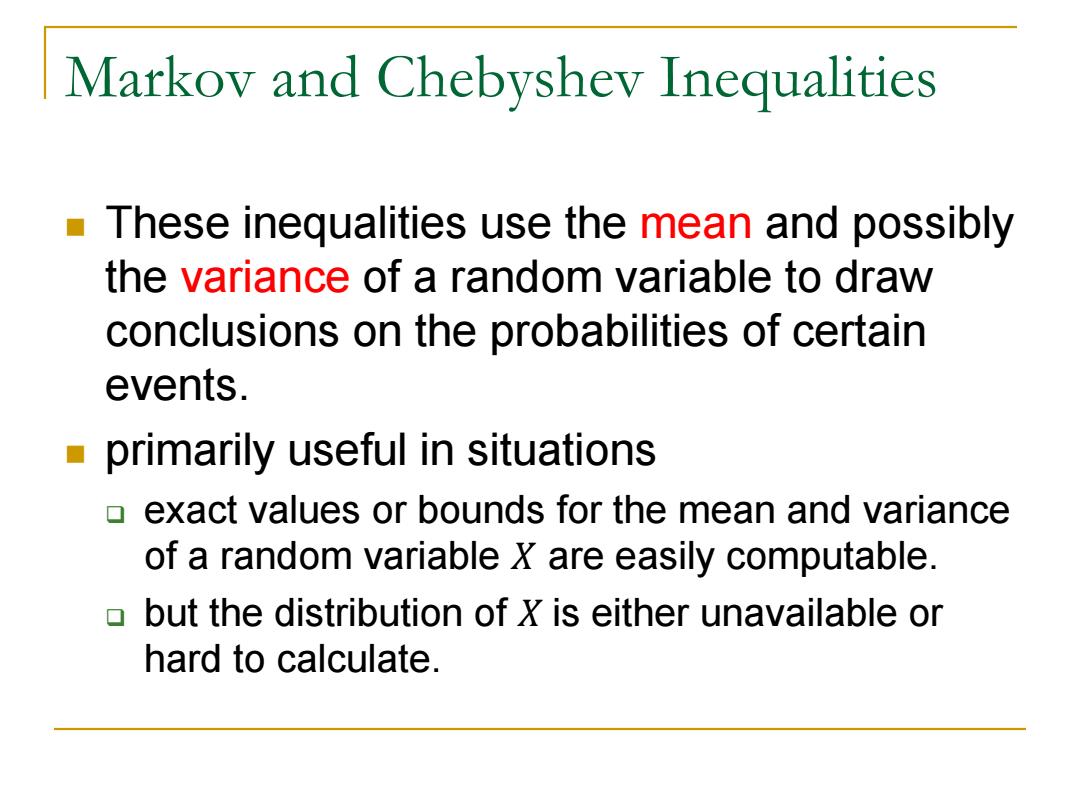
Application (b)They allow for an approximate analysis of the properties of random variables such as Sm. o This is to be contrasted with an exact analysis which requires a formula for the PMF or PDF of S, a complicated and tedious task when n is large. (c)They play a major role in inference and statistics,in the presence of large data sets
Application (b) They allow for an approximate analysis of the properties of random variables such as 𝑆𝑛. This is to be contrasted with an exact analysis which requires a formula for the PMF or PDF of 𝑆𝑛, a complicated and tedious task when 𝑛 is large. (c) They play a major role in inference and statistics, in the presence of large data sets

Content Markov and Chebyshev Inequalities The Weak Law of Large Numbers ■ Convergence in Probability The Central Limit Theorem The Strong Law of Large Numbers
Content Markov and Chebyshev Inequalities The Weak Law of Large Numbers Convergence in Probability The Central Limit Theorem The Strong Law of Large Numbers

Markov and Chebyshev Inequalities These inequalities use the mean and possibly the variance of a random variable to draw conclusions on the probabilities of certain events. primarily useful in situations exact values or bounds for the mean and variance of a random variable X are easily computable. o but the distribution of X is either unavailable or hard to calculate
Markov and Chebyshev Inequalities These inequalities use the mean and possibly the variance of a random variable to draw conclusions on the probabilities of certain events. primarily useful in situations exact values or bounds for the mean and variance of a random variable 𝑋 are easily computable. but the distribution of 𝑋 is either unavailable or hard to calculate

Markov inequality Theorem (Markov Inequality).If a random variable X can only take nonnegative values, then P(X≥a)≤ELX for all a 0 a If a nonnegative random variable has a small mean,then the probability that it takes a large value must also be small
Markov inequality Theorem (Markov Inequality). If a random variable 𝑋 can only take nonnegative values, then 𝑃 𝑋 ≥ 𝑎 ≤ 𝐸 𝑋 𝑎 , for all 𝑎 > 0 If a nonnegative random variable has a small mean, then the probability that it takes a large value must also be small

Markov inequality (proof) To justify the Markov inequality,let us fix a positive number a and consider the random variable Y defined by Ya= 0, ifX<a, la, ifX≥a. It is seen that the relation Ya≤X always holds and therefore E[Ya]≤E[X]:
Markov inequality (proof) To justify the Markov inequality, let us fix a positive number 𝑎 and consider the random variable 𝑌𝑎 defined by 𝑌𝑎 = 0, if 𝑋 < 𝑎, 𝑎, if 𝑋 ≥ 𝑎. It is seen that the relation 𝑌𝑎 ≤ 𝑋 always holds and therefore 𝐄 𝑌𝑎 ≤ 𝐄[𝑋]